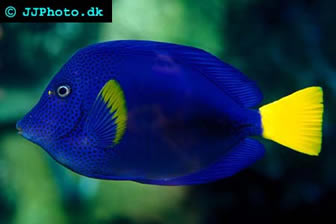Surgeonfish - Tangs
The Surgeonfishes are found in the family Acanthuridae ("thorn tail") together with tangs and unicornfishes. All the members of Acanthuridae live in tropical waters and prefer to stay close to coral reefs. Acanthuridae contains about 80 species of which five are found in the Atlantic while the rest inhabit the Pacific Ocean and the Indian Ocean.
Many surgeon fishes are brightly coloured and their popularity among aquarists is not hard to understand. Some species will shift colour as they mature. In addition to being beautiful, surgeon fishes will also help control excessive algae growth in the aquarium and they are praised for their fondness of eating even thread algae. Surgeonfish is not a good choice if you have beautiful algae in your aquarium that you wish to keep because the surgeon will devour them.
Surgeonfishes are considered fairly tricky to keep and are not recommended for novice marine aquarists. The can grow fast and it is therefore always important to check the maximal size of the species you are interested in before you add it to your aquarium.
The surgeonfish derives its name from the sharp pair of spines that can be found on either side of the tail. These spines will normally be relaxed, but they can be raised by the surgeon fish and used as dangerously sharp weapons. Fellow fishes are not the only ones who have experienced the sharp sting of the spikes; fishermen and careless aquarists are also common targets.
The body of a surgeonfish is deep and laterally compressed with high set eyes. The body is protected by tiny scales. Both dorsal and anal fins are large and extend for most of the length of the body. The mouth is comparatively small and contains a single row of narrowly set sharp teeth which is used to graze algae.
Surgeon fishes are extremely important for the coral reef since they will use their sharp teeth to free the corals from algae. Without continuous grazing, the corals would soon be overgrown with algae and this would ultimately kill them. A few species of surgeon fish feed primarily on zooplankton and detritus instead of grazing algae.
If you want to keep surgeon fish you should ideally provide them with an aquarium filled with plenty of live rock and algae. The smallest species, such as Zebrasoma flavescens, can be kept in a 200 L (53 gallon) aquarium. Zebrasoma flavescens is not only small; it is also a peaceful species that can be kept in a community aquarium with other peaceful fishes.
If you wish to keep one of the larger surgeonfishes you will need a 1000 L (275 gallon) aquarium or larger since they can reach a length of 30 cm (1 foot). Large surgeons are typically highly territorial and will not hesitate to use violence to guard their territory. Keeping several members of the same species is difficult, unless you have a really large and cleverly decorated aquarium with room for several territories.
Surgeonfish - Tang Articles:
Achilles Surgeonfish – Acanthurus achilles
Atlantic Blue Tang – Acanthurus coeruleus
Blue Hippo Tang – Paracanthurus hepatus
Chevron Tang – Ctenochaetus hawaiiensis
Clown Surgeonfish – Acanthurus lineatus
Convict Surgeonfish – Acanthurus triostegus
Desjardinii Tang – Zebrasoma desjardinii
Kole Tang – Ctenochaetus strigosus
Mimic Surgeonfish – Acanthurus pyroferus
Naso Tang – Naso lituratus
Orangeshoulder Surgeonfish – Acanthurus olivaceus
Powder Blue Tang – Acanthurus leucosternon
Powder Brown Tang – Acanthurus japonica
Purple Tang – Zebrasoma xanthurum
Sailfin Tang – Zebrasoma veliferum
Scopas Tang – Zebrasoma scopas
Whitecheek Surgeonfish – Acanthurus nigricans
Yellow Tang – Zebrasoma flavescens

